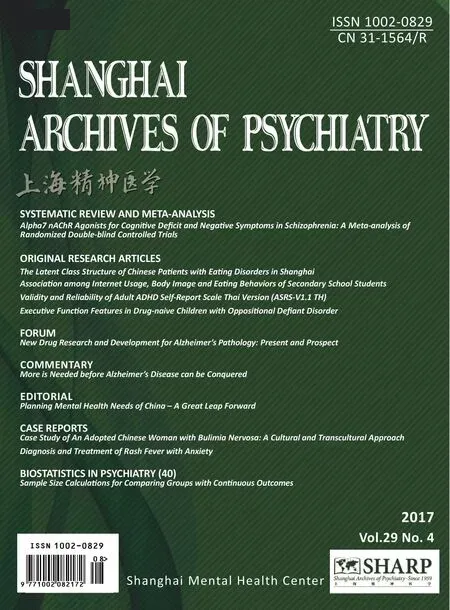More is Needed before Alzheimer’s Disease can be Conquered
Xin YU
[Shanghai Arch Psychiatry. 2017; 29(4): 240-241. doi: http://dx.doi.org/10.11919/j.issn.1002-0829.217073]
•COMMENTARY•
More is Needed before Alzheimer’s Disease can be Conquered
Xin YU
[Shanghai Arch Psychiatry. 2017; 29(4): 240-241. doi: http://dx.doi.org/10.11919/j.issn.1002-0829.217073]
German Neurologist Alois Alzheimer first reported the autopsy results of a fifty year old female patient named Auguste Deter in 1907. The patient presented with classic cognitive and behavioral disorder. The autopsy results showed two abnormal pathological changes:neurofibrillary tangles (NFTs) and senile plaques (SPs). In 1924 Divery found that SPs consisted of amyloid using Congo red staining. In 1984, Glenner and Wong purified a 4.2 kDa β-amyloid (Aβ) from a patient with Alzheimer’s disease (AD) with cerebral amyloid angiopathy (CAA).The sequencing analysis showed Aβ was a peptide containing 39-43 amino-acids, moreover Aβ40 and Aβ42 were main types.[1]Hardy and Selkoe proposed the amyloid cascade hypothesis in later years. Amyloid precursor protein (APP) severing disorder lead to over expression or less clearance of Aβ, and then Aβ became aggregated. In particular, Aβ42 accumulation caused synaptic degeneration, inflammation, oxidative stress,NFTs, neuron loss, and so on.[2]Not long afterwards,several massive, multidimensional, long-term clinical studies showed a relationship between Aβ deposition in the brain and dementia using demic biomarker analysis.[3,4]
On the one hand, this may show why Aβ-target strategies in AD drug development were always unsuccessful, but many pharmaceutical factories and labs still insisted on studying AD drugs because over the past 20 years of research a foundation for the pathological mechanism of AD has been established.Although its not necessary to completely start over,it is clear Aβ-targeting drugs are not the final answer.In addition to what other researchers have reported in detail there are other ideas to consider. First, the neurophysiological and neurotoxic effects of Aβ soluble monomer, oligomer and insoluble amyloid plaques are not clear. We have less knowledge about the clinical benefits of indiscriminate removal in passive immunotherapy. Second, Aβ deposit in the brain begins ten years before clinical symptoms of dementia begin to appear This progress can also be observed in normal aged brains. Does Aβ have a dramatic increase in AD brains compared to non-cognitive impairment (NCI)? Or are AD brain neurons more sensitive to Aβ, which leads to neural impairment and irreversible neuron apoptosis?We lack evidence for both of these questions. Third,although Aβ and Tau are two individual pathological processes in AD, more and more results have shown relationships between them. However, almost all studies to this point have concentrated on either Aβ or Tau, and few clinical studies have combined both of them as a target for treatment. Fourth, genetic and environmental factors, which cause Aβ or Tau overexpression, may accelerate neuron aging. It is synchronous between Aβ deposition, Tau hyperphosphorylation and neural synapse degeneration, hypocytometabolism, cytothesis impairment. Clearance of Aβ or Tau cannot reverse neuron aging.
While several clinical tests have been unsuccessful we should continue in our efforts to conquer AD. At the same time, it is necessary to realize the complexity of the brain and brain diseases. Aging also plays an important role. Therefore it will be difficult to make a great breakthrough in the treatment of AD if our methods are only from a disease perspective.
Funding statement
Conflict of interest statement
The author has no conflict of interest to declare.
1. Glenner GG, Wong CW. Alzheimer’s disease: initial report of the purification and characterization of a novel cerebrovascular amyloid protein. Biochem Biophys Res Commun.1984; 425: 534-539
2. Hardy J, Selkoe DJ. The amyloid hypothesis of Alzheimer’s disease: progress and problems on the road to therapeutics. Science. 2002; 297: 353-356. doi: https://doi.org/10.1126/science.1072994
3. Beckett LA, Harvey DJ, Gamst A, Donohue M, Kornak J,Zhang H, et al. ADNI: Annual change in biomarkers and clinical outcomes. Alzheimers Dement. 2010; 6(3): 257-264. doi: https://doi.org/10.1016/j.jalz.2010.03.002
4. Benzinger T, Blazey T, Koeppe R, Jack C, Raichle M, Su Y, et al. Elevated PiB precedes dementia in autosomal-dominant Alzheimer’s disease: PiB, FDG and atrophy in the DIAN cohort. Alzheimers Dement. 2012; 8(4): 57-58. doi: https://doi.org/10.1016/j.jalz.2012.05.1857
no external funding.
Peking University Sixth Hospital, Peking, China
correspondence: Professor Xin YU. Mailing address: Peking University Sixth Hospital, Beijing, China. Postcode: 100191. E-Mail: yuxin@bjmu.edu.cn

Professor Xin Yu obtained a bachelor’s degree from Beijing Medical University in 1988 and a MD degree from Peking University in 2000. He has been working at Peking University Institute of Mental Health since 1988. He is a professor in the department of Clinical Psychiatry. He is also the immediate past president of the Chinese Society of Psychiatry. His research interest is geriatric psychiatry.
- 上海精神医学的其它文章
- Alpha7 nAChR Agonists for Cognitive Deficit and Negative Symptoms in Schizophrenia: A Meta-analysis of Randomized Double-blind Controlled Trials
- Association among Internet Usage, Body Image and Eating Behaviors of Secondary School Students
- Validity and Reliability of Adult ADHD Self-Report Scale Thai Version (ASRS-V1.1 TH)
- Executive Function Features in Drug-naive Children with Oppositional Defiant Disorder
- New Drug Research and Development for Alzheimer’s Pathology:Present and Prospect
- Planning Mental Health Needs of China – A Great Leap Forward

